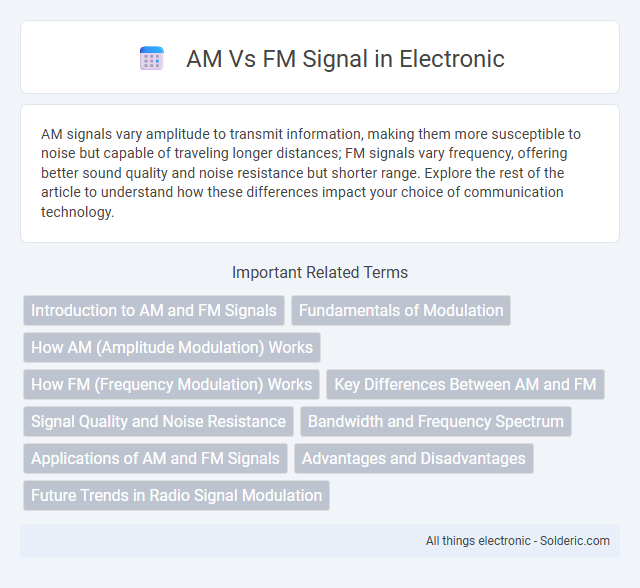AM signals vary amplitude to transmit information, making them more susceptible to noise but capable of traveling longer distances; FM signals vary frequency, offering better sound quality and noise resistance but shorter range. Explore the rest of the article to understand how these differences impact your choice of communication technology.
Comparison Table
| Feature | AM (Amplitude Modulation) | FM (Frequency Modulation) |
|---|---|---|
| Modulation Type | Amplitude varies | Frequency varies |
| Bandwidth | Narrower bandwidth (up to 10 kHz) | Wider bandwidth (up to 200 kHz) |
| Noise Immunity | Low (prone to static) | High (resistant to noise) |
| Signal Quality | Lower fidelity | Higher fidelity |
| Range | Longer range, can travel longer distances | Shorter range, limited by line-of-sight |
| Applications | AM Radio, Aviation communication | FM Radio, TV sound, mobile phones |
| Power Efficiency | Less efficient | More efficient |
Introduction to AM and FM Signals
AM (Amplitude Modulation) signals vary the amplitude of the carrier wave in proportion to the input audio signal, making them widely used for long-distance broadcast radio due to their simpler technology and better signal range. FM (Frequency Modulation) signals change the frequency of the carrier wave based on the input signal, offering superior sound quality and resistance to noise, which is ideal for music and high-fidelity broadcasting. Both AM and FM are essential radio transmission methods with distinct characteristics affecting bandwidth, signal clarity, and applications.
Fundamentals of Modulation
Amplitude Modulation (AM) varies the carrier wave's amplitude in proportion to the information signal, while Frequency Modulation (FM) changes the carrier wave's frequency based on the input signal. AM signals are more susceptible to noise due to amplitude variations, whereas FM signals offer better noise immunity by encoding information in frequency deviations. The modulation index in AM is the ratio of signal amplitude to carrier amplitude, whereas in FM it represents the frequency deviation relative to the modulating signal frequency.
How AM (Amplitude Modulation) Works
AM (Amplitude Modulation) works by varying the amplitude of the carrier wave in proportion to the instantaneous amplitude of the input signal, which typically carries audio information. The frequency and phase of the carrier wave remain constant while the amplitude changes encode the information. Demodulation of the AM signal involves detecting these amplitude variations to reconstruct the original audio signal.
How FM (Frequency Modulation) Works
FM (Frequency Modulation) works by varying the frequency of the carrier wave in direct proportion to the amplitude of the input audio signal, enabling more accurate sound reproduction compared to AM. This method reduces noise interference and static, as frequency changes are less affected by signal strength variations. Understanding how FM operates can help you appreciate the enhanced audio quality and reliability it offers for radio broadcasting.
Key Differences Between AM and FM
AM (Amplitude Modulation) varies the signal's amplitude to encode information, whereas FM (Frequency Modulation) changes the signal's frequency. AM signals are more susceptible to noise and static interference, while FM provides better sound quality due to higher resistance to noise. AM is commonly used in long-distance broadcasting, and FM is preferred for high-fidelity audio transmissions over shorter ranges.
Signal Quality and Noise Resistance
FM signals offer superior noise resistance compared to AM signals due to their frequency modulation technique, which makes them less susceptible to amplitude-based noise and interference. AM signals are more prone to static and signal degradation caused by electrical equipment and atmospheric conditions because their amplitude varies with the information signal. The robustness of FM in maintaining signal quality results in clearer audio transmission, especially in environments with high electromagnetic interference.
Bandwidth and Frequency Spectrum
AM signals typically occupy a narrower bandwidth, usually twice the modulating signal's frequency, resulting in a spectrum concentrated around the carrier frequency with sidebands that contain the audio information. FM signals demand a wider bandwidth due to frequency deviations caused by modulation, often several times the modulating frequency, leading to a broader frequency spectrum that enhances noise resistance and sound quality. The Carson's Rule estimates FM bandwidth as twice the sum of the peak frequency deviation and the modulating frequency, highlighting the substantial difference compared to the fixed, narrower bandwidth of AM transmissions.
Applications of AM and FM Signals
AM signals are primarily used in long-distance radio broadcasting, aviation communication, and maritime communication due to their ability to travel vast distances and penetrate obstacles effectively. FM signals dominate in high-fidelity sound transmission applications such as commercial FM radio, television sound, and two-way radio communication because of their superior noise rejection and audio quality. Both modulation techniques serve critical roles in emergency communication systems, ensuring reliable information dissemination in varying environmental conditions.
Advantages and Disadvantages
AM signals offer greater range and better signal penetration through obstacles, making them ideal for long-distance communication and rural areas. FM signals provide superior sound quality and resistance to noise and interference, making them preferred for music broadcasting and urban environments. However, AM signals suffer from susceptibility to static and lower audio fidelity, while FM signals have limited range and require line-of-sight transmission.
Future Trends in Radio Signal Modulation
Future trends in radio signal modulation emphasize advanced digital techniques enhancing both AM and FM signals for improved clarity and efficiency. Software-defined radio (SDR) and cognitive radio technologies enable dynamic spectrum management, optimizing signal quality and reducing interference. Your experience will benefit from increased data transmission rates and enhanced robustness in diverse communication environments.
AM vs FM signal Infographic

 solderic.com
solderic.com